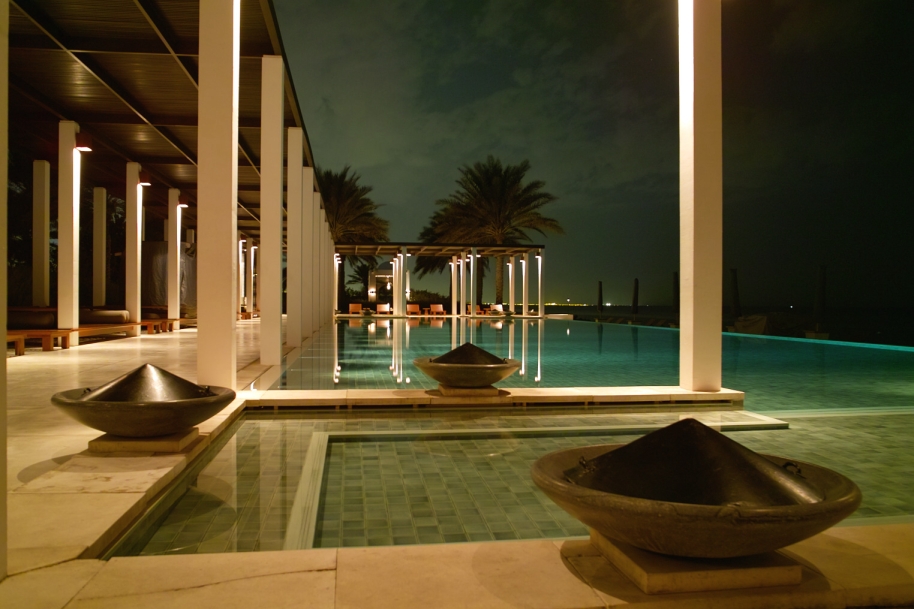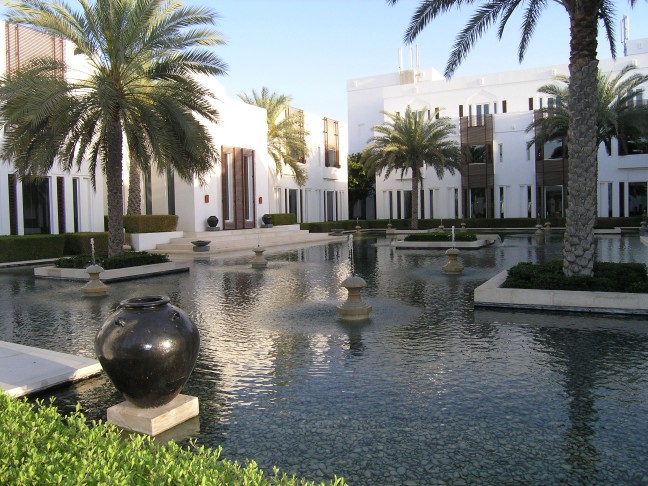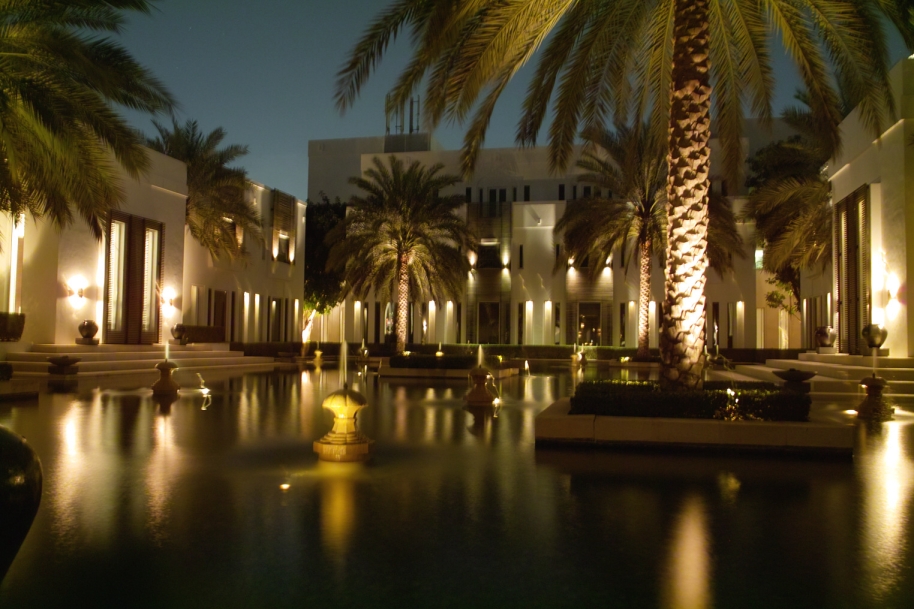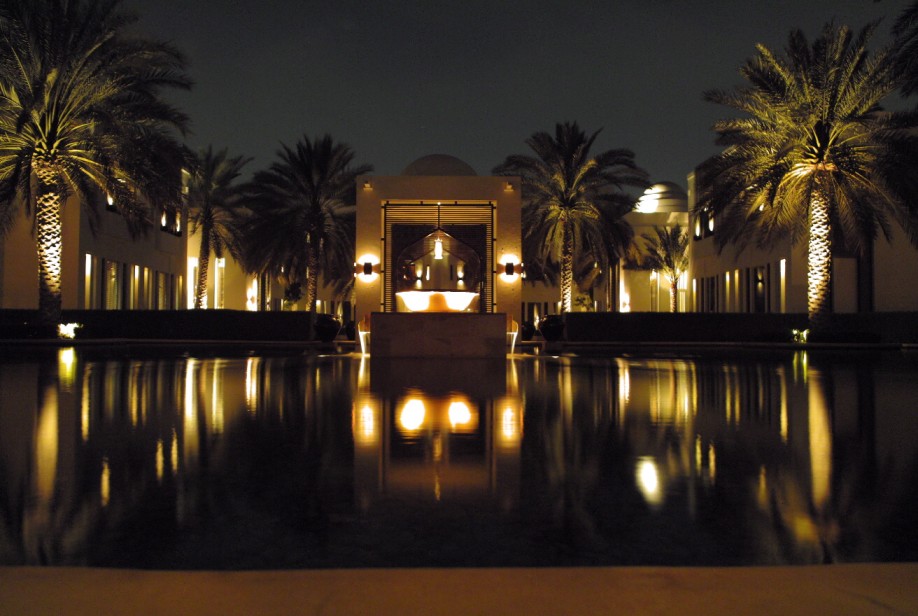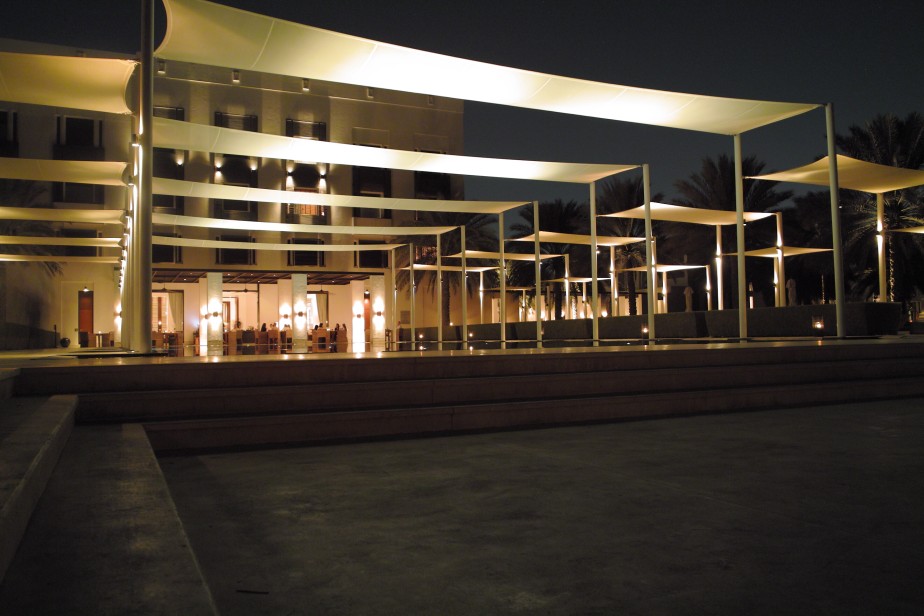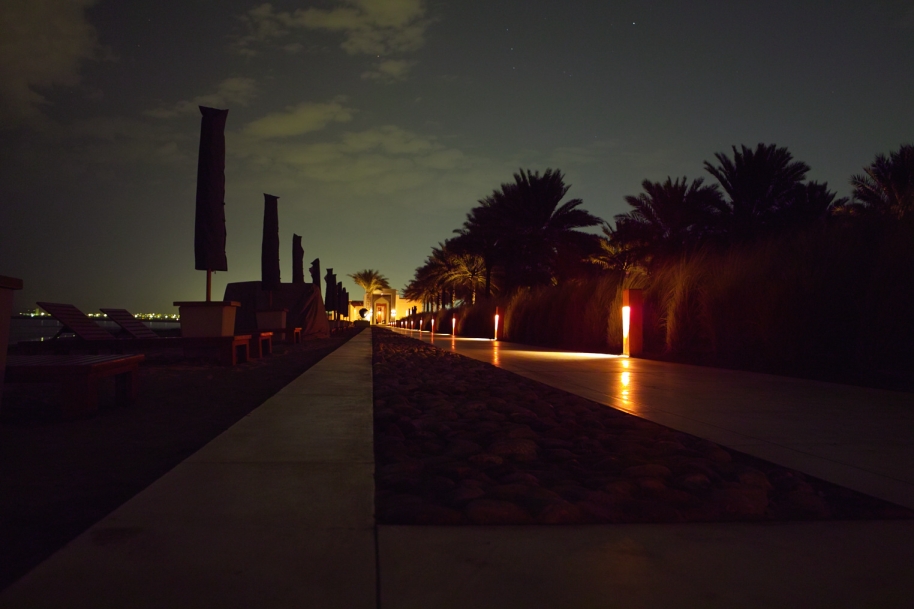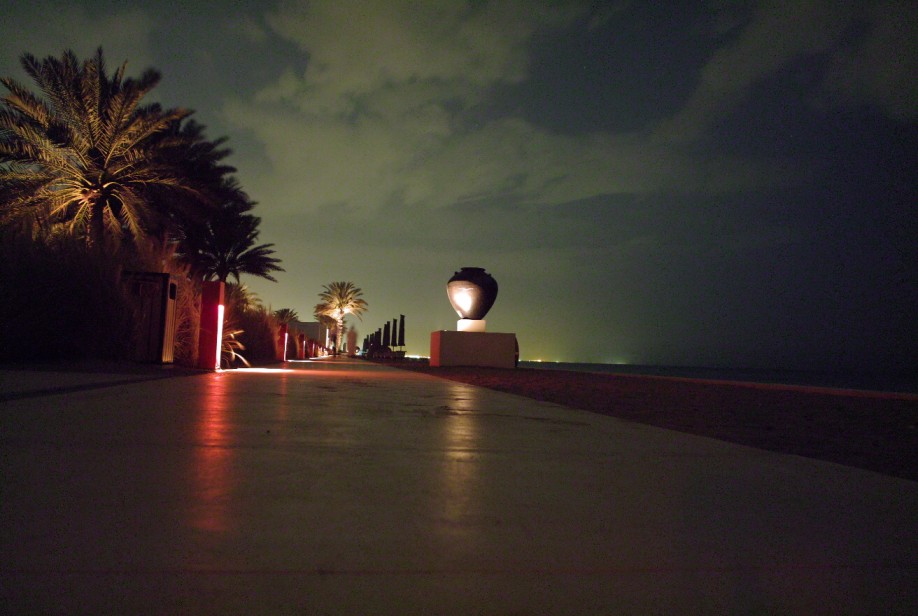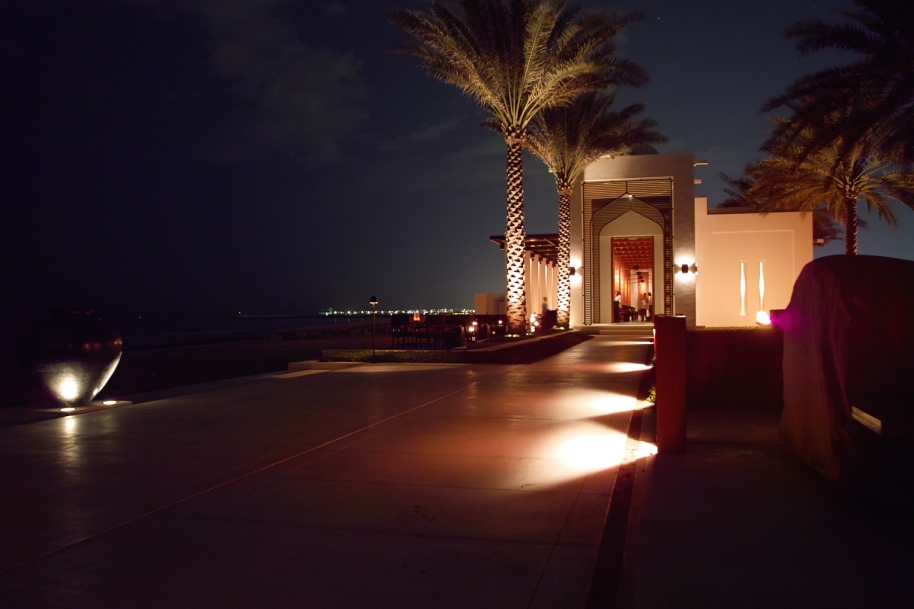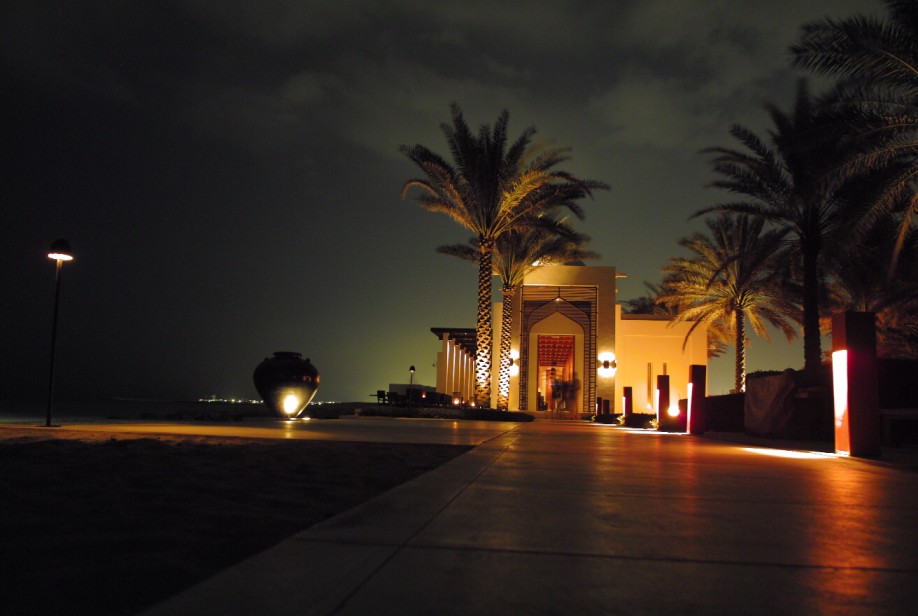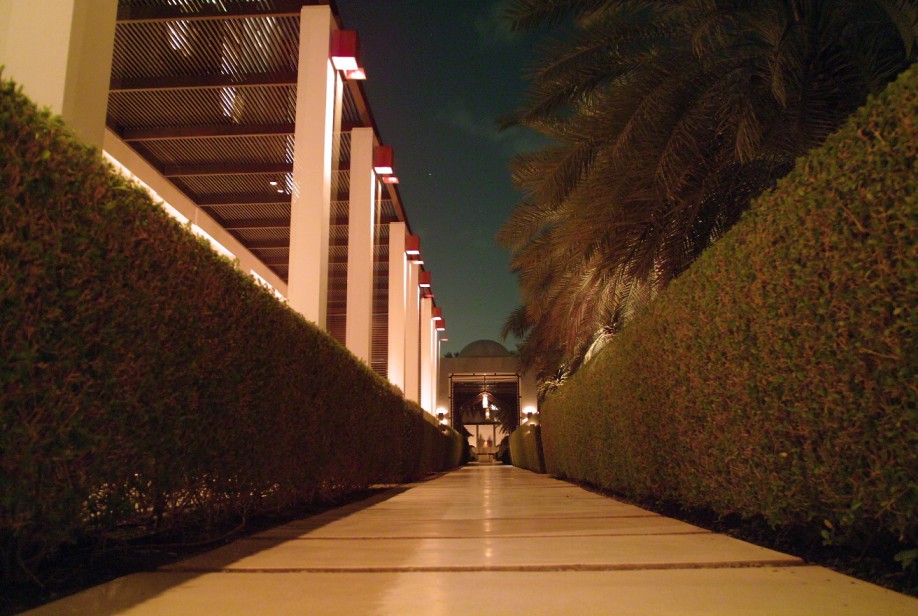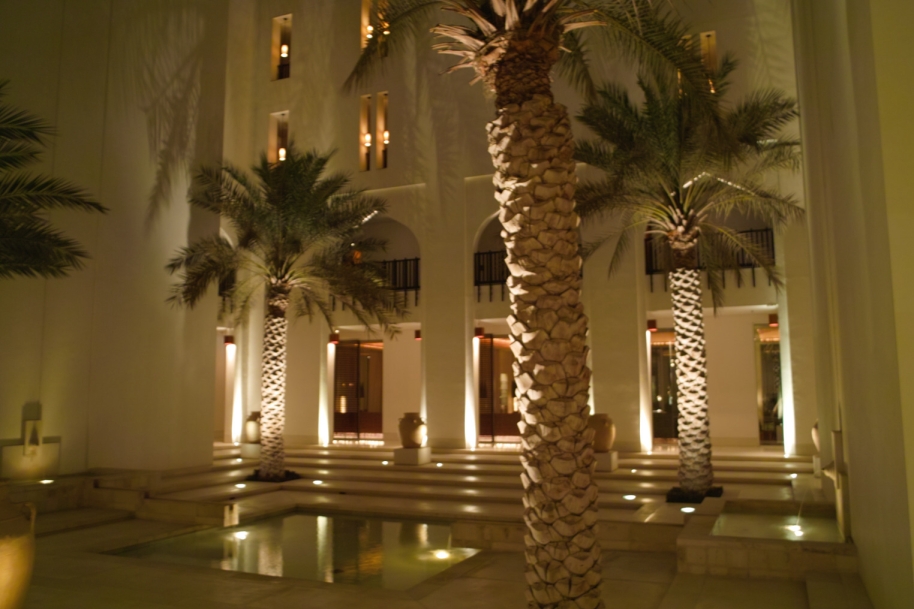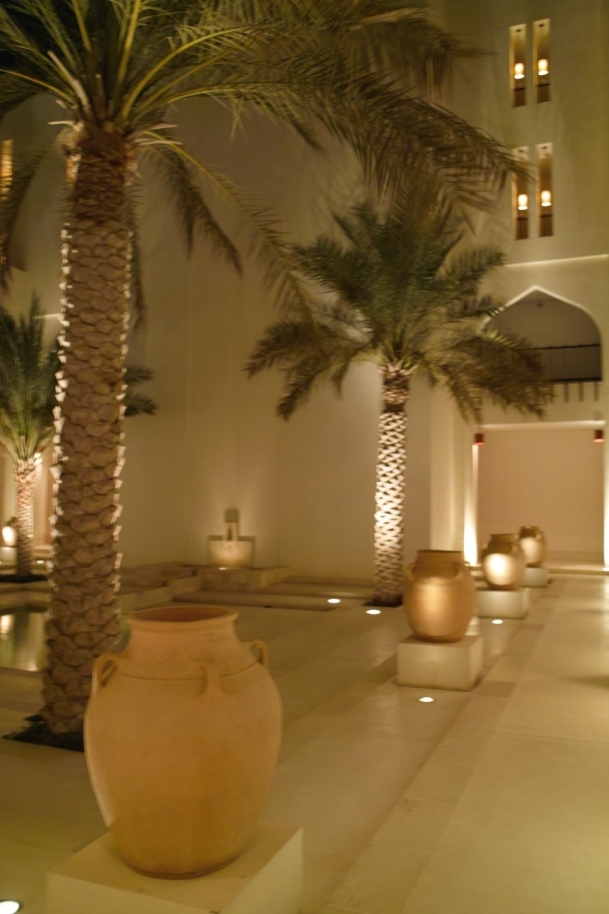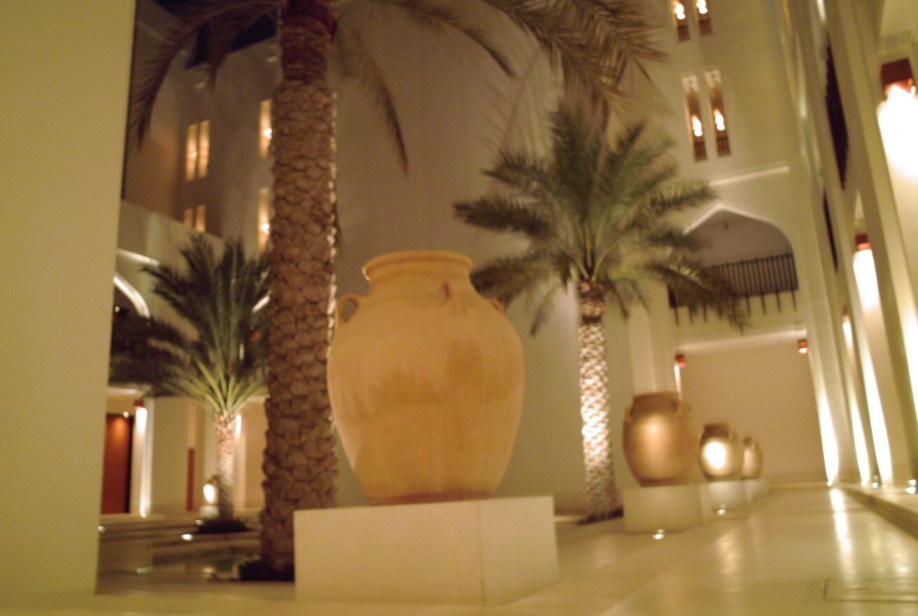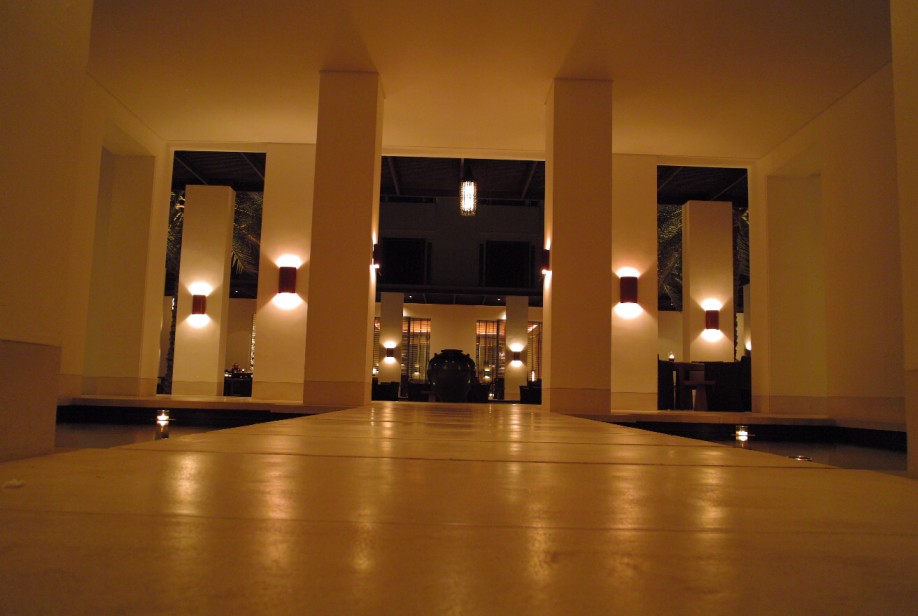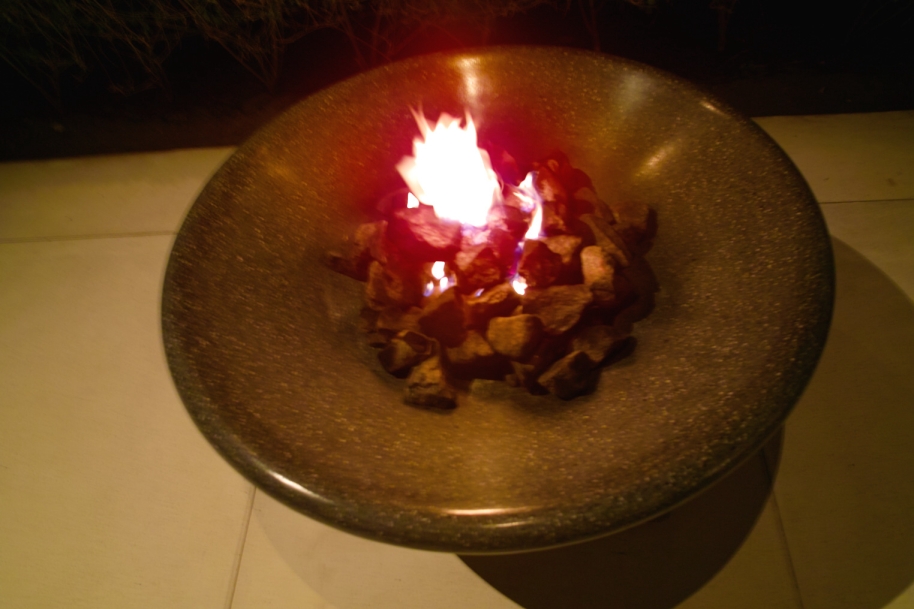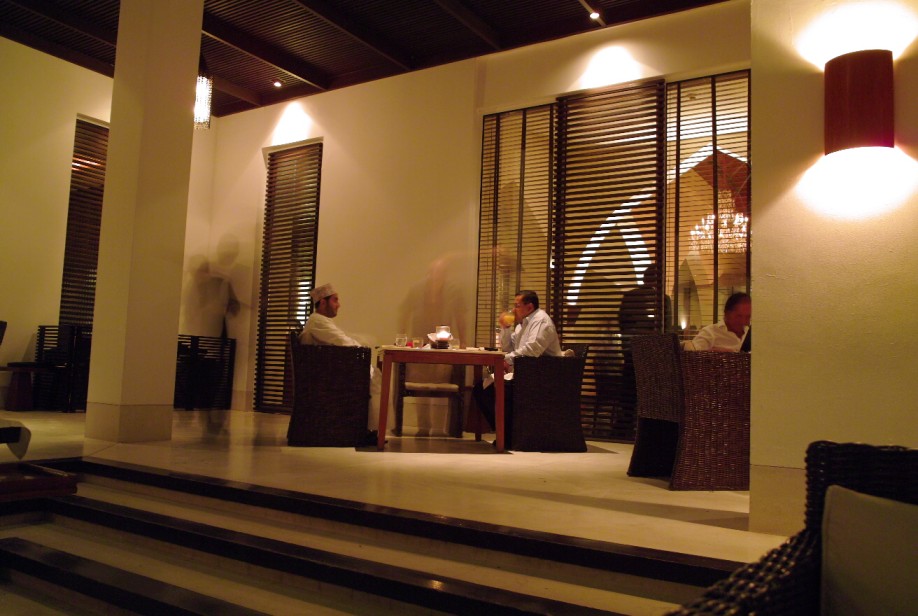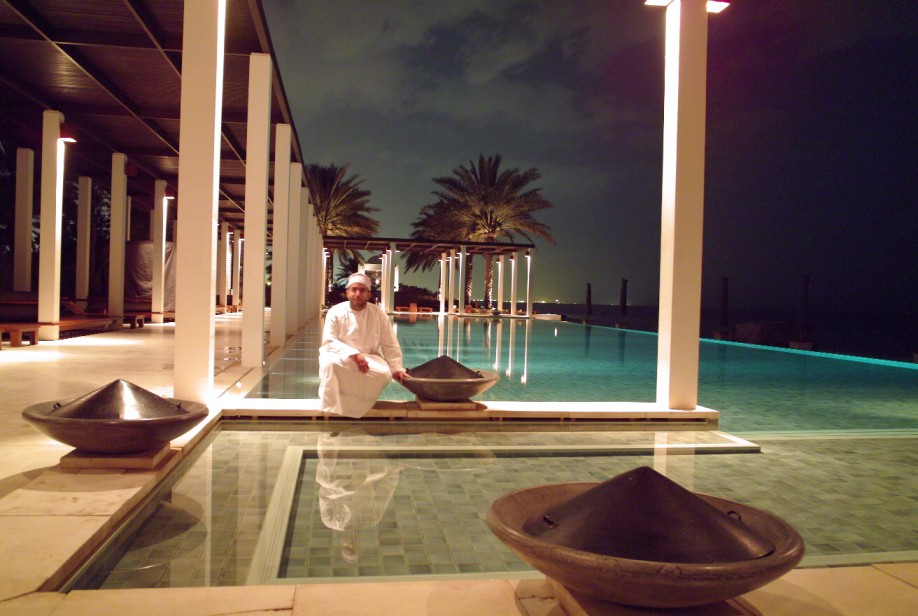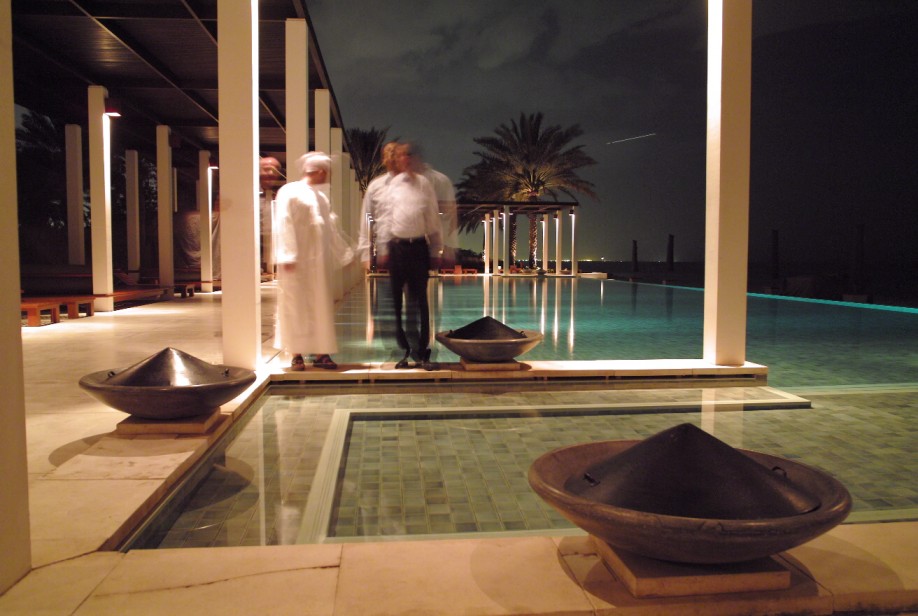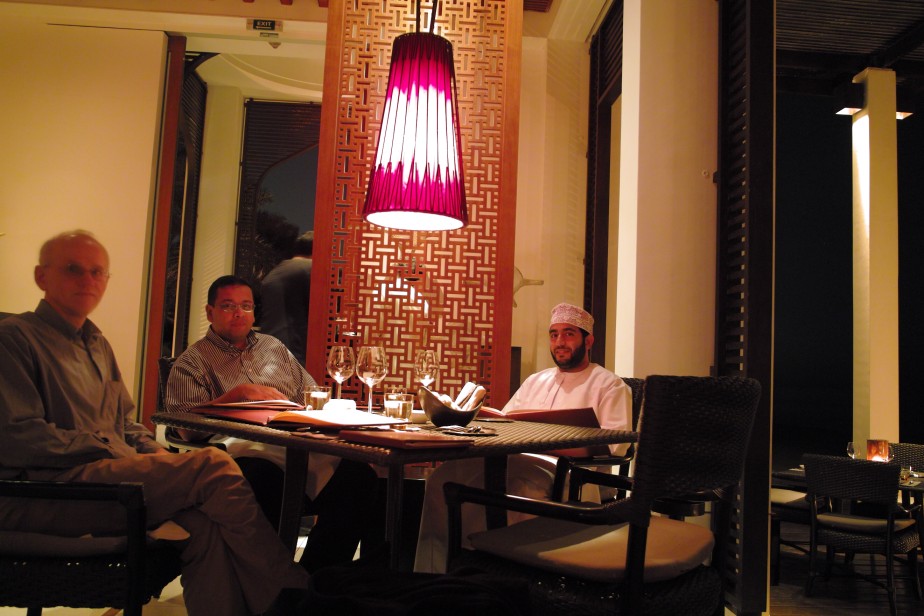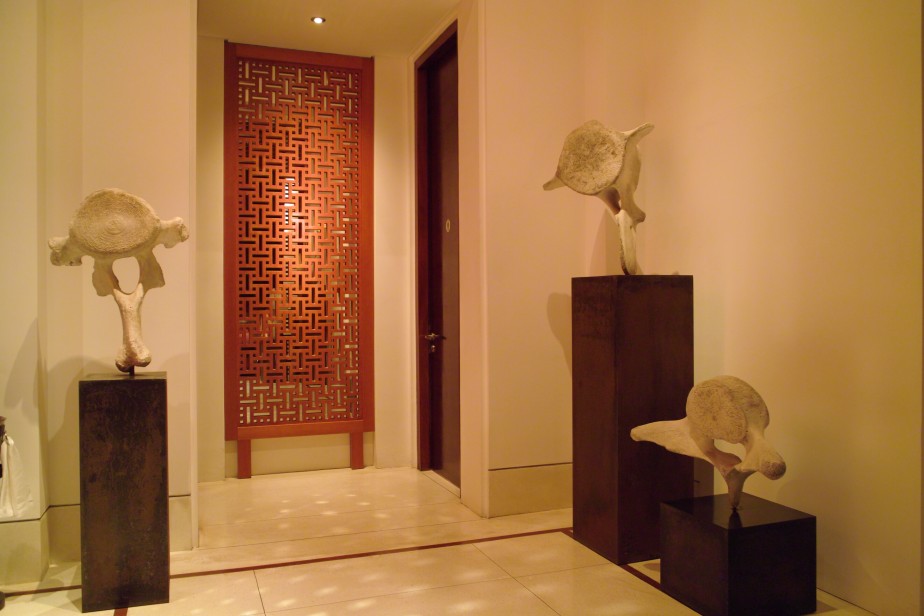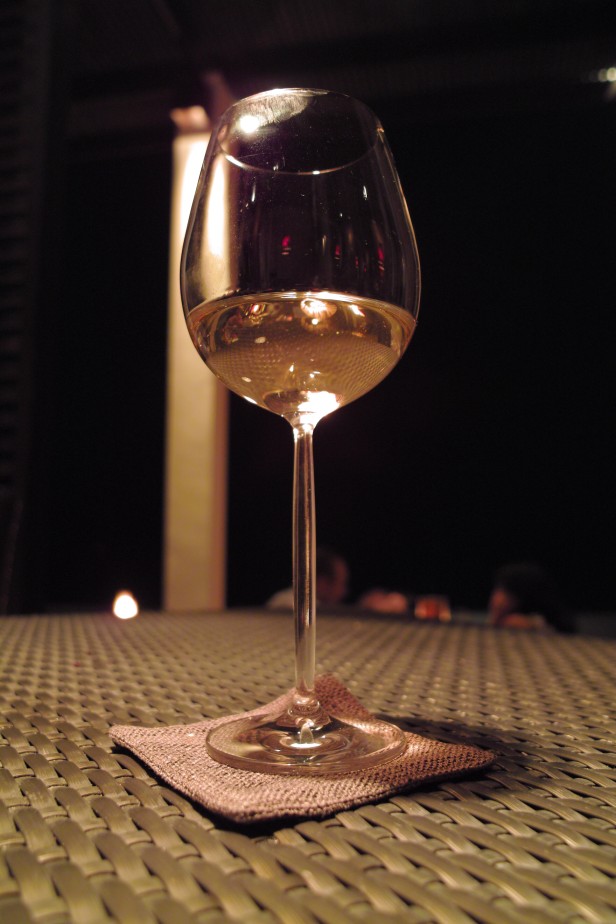Home page: www.treks.org
Table of Contents "Short stories of treks"
Oman
The Chedi Hotel in Muscat
(Oman, April 2005)
The pool by the sea by night (click on pictures to enlarge). 8 MByte picture With Ali. With Ali and Ahmed.
The Chedi garden with ponds, palm trees and
fountains.
Same by night
Same by night
It is dark and I am walking through the large
scenic hotel garden. The dim light and
the faint rustling sound of the many fountains in the ponds [1] give it a tranquil atmosphere. It
is still humid and warm, mid thirties.
I rest on a couch on a terrace outside the
lounge and watch the red flames curling up from the burning charcoal in the
transparent glass bowl. This hotel is like a museum of modern art.
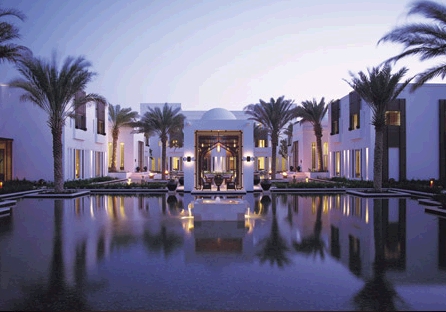
The Chedi, a large pond
with palm trees by night.
GHM Hotels
DHM Hotels,
see http://www.ghmhotels.com/ is a
chain of luxurious resort hotels in Asia. Best known are two hotels on
Bali, the Legian and the Club at the
Legian, and on the Malaysian island of Langkawi, the Datai and the Adaman.
Their target audience is the high end luxury tourist market. Rooms are 400-500 dollars per night for a double but
you can get a better deal if you book a package deal.
Resort Hotels
For the
past 10 years there is a trend to build well designed resort hotels for the
high end tourist market. They feature prominently in travel magazines and
advertise their exclusiveness. Designed
with natural colours, space, panoramic views, a large garden, quietness,
discrete and friendly personnel and
healthy, food gives it a perfect mix for spoiled tourists used to the comfort
of 5 star business hotels but seeking the tranquility of a private resort. The
more remote, the less expensive these hotels are but you may have to travel 24
hours.
E.g. the Empire Hotel in Brunei on the Island of
Borneo is only US $200 per night for a double room but from Europe it is a 20
hour trip. It even has a masters golf course which is hardly used.
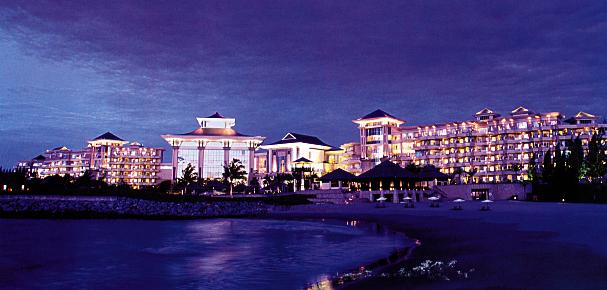
Empire Hotel Brunei
Design Hotels
Another trend are the stylish hotels in large
cities. E.g. The Dylan Hotel in Amsterdam.
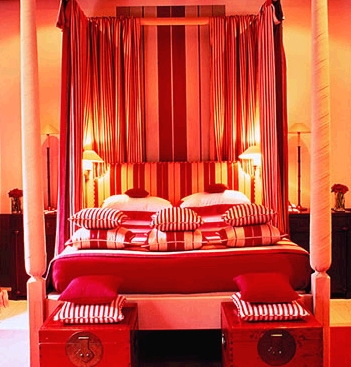
A red room in The Dylan Hotel (formerly Blakes) in Amsterdam.
This is a small and luxurious hotel on the
Keizersgracht with rooms in different styles and is formerly known as Blakes.
Prices are 1000-1500 Euros a night, even higher than the well-known Amstel
Hotel. If I was a movie star like George Clooney shooting a movie in Amsterdam
I would have stayed at The Dylan and not the Amstel Hotel.
In Dubai there is the Burj Al Arab hotel, the
building in the shape of a sail. Prices are around US $800 per night. It is
popular for the Western expats to stay here often managing to get a better price.
Travel agents in the UK also give good deals.
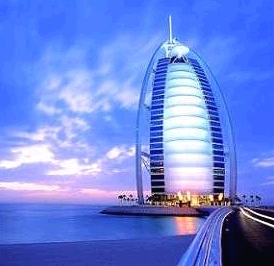
Burj Al Arab Hotel in Dubai.
Muscat
Muscat has
three majestic hotels for the high end business traveler and tourist market, the
Al Bustan Palace, the Hyatt and The Chedi. I personally prefer the tranquil
atmosphere of The Chedi but the other
two also have a grandeur.
Al Bustan Palace
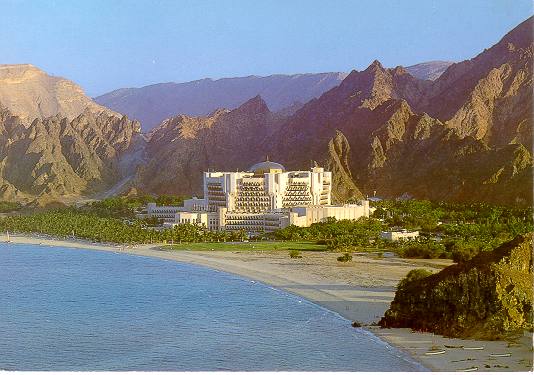
The Al
Bustan Palace is South-East of Muscat on the coast and isolated surrounded low
mountain ridges. The main building is a high dome with typical Arab white and
light blue tiles. It has a very large private garden and is said to have good
diving on the rocky parts of the coast.
The Hyatt
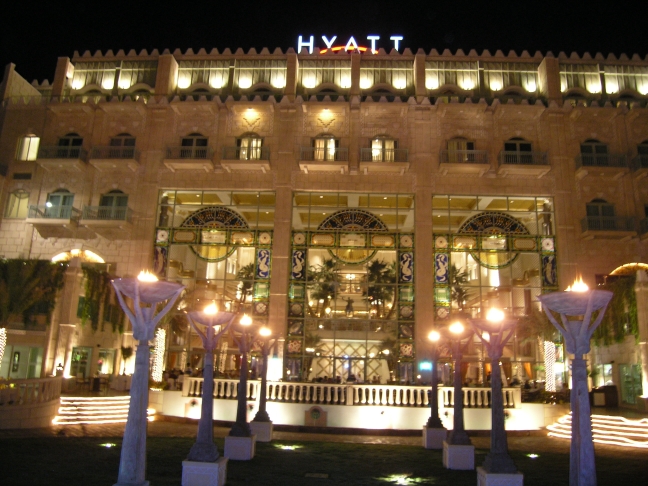
The
Hyatt Hotel terrace by night with the gas torches.
The Hyatt is built in the style of a Sahara
safari hotel. It has a dominantly Arab or perhaps Yemenite style mixed in with
African features like numerous sculptures of wild African animals and Arabian
horse men [1].
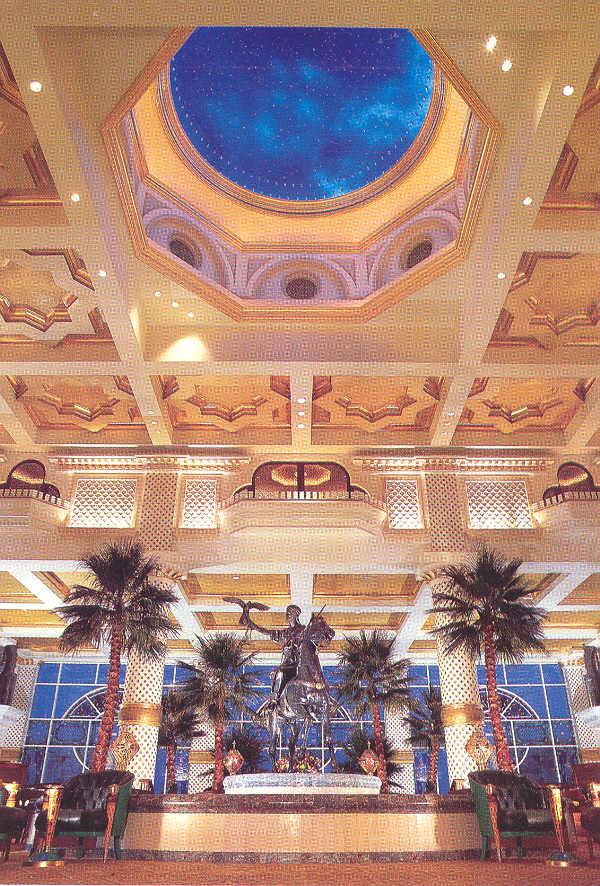
It was built by an impoverished Yemenite Prince
who found a ship treasure in The Gulf that carried cash money and was sunk by a
German U-boat in 1944. Unfortunately, he went broke when building the hotel and
I can see why, his taste was royal.
The buffet of the Mokka restaurant is excellent, especially the salad
bar [1]. The problem remains
overeating on the fish, meat and deserts and you better focus at the salad bar.
At night, the garden is lit by two rows of
torches. It all looks nice but they garden is not very inviting for walking as
it is dominated by the pools [1].
The beach boulevard is much nicer. There is a palm-lined
walk-way of 2-3 km leading to the Intercontinental and this has a few local cafes.
At night it is busy with walking Omanis, men and women. Despite being dark at
night, there is zero fear for being mugged not only by the local men but also
the women who often go out unaccompanied by men..
The beach
is wide and there is usually a strong warm breeze from the warm Arabian Sea.
The flood-line is excellent for jogging. My favorite route leads from the Hyatt
to past the Intercontinental Hotel, till the Al Qurm mangrove forest bridge, 3
km one way. Along the way, you pass numerous soccer games, encouraging public. From 3-6 PM there are some 200
young men playing on the wide beach.
The Chedi
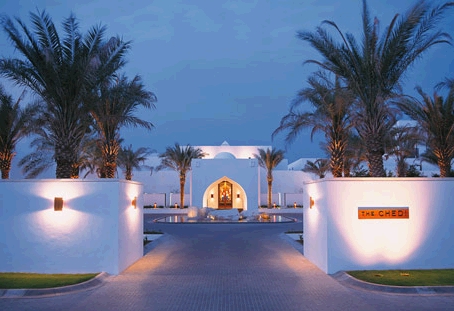
The Chedi, entrance
The Chedi is North of the Al Ghubbrah roundabout but is easier to
find using the road that runs parallel to the highway from the Hyatt along the
ministries. There is a large sign on the road indicating the hotel entrance but
the buildings are 500 m from the road and all you see is a low white wall that
surrounds a square km large empty area with white building in the distance.
At the entrance [1] [1] you may be welcomed by a bell
man in a traditional Omani costume and the typical Omani dagger.
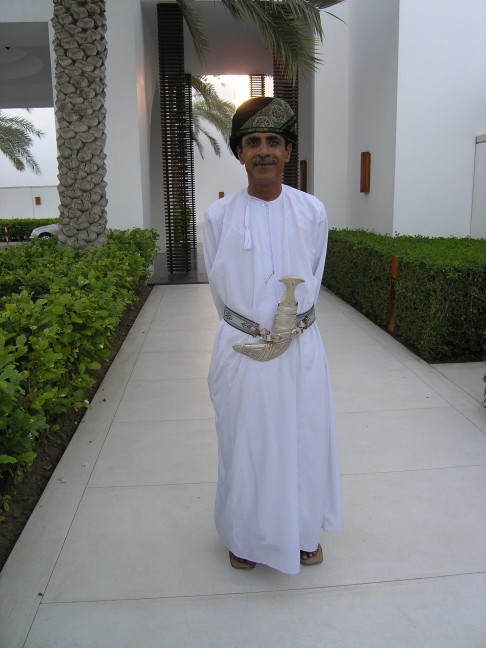
The Chedi, traditional
costume of the bell man.
The main entrance has a
pond with large rough stones [1]
and reeds. Very Feng-Shui, I am told.
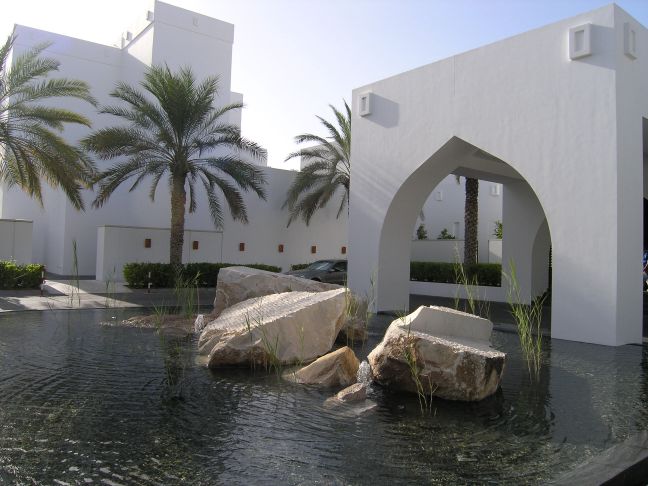
Entrance with pond and
large boulders.
The reception and the main
hall are very special as if entering a posh private home with a flavor of a
church or mosque.
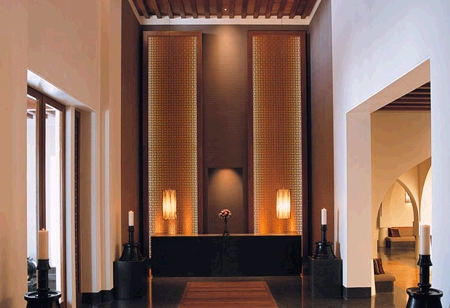
The Chedi, reception.
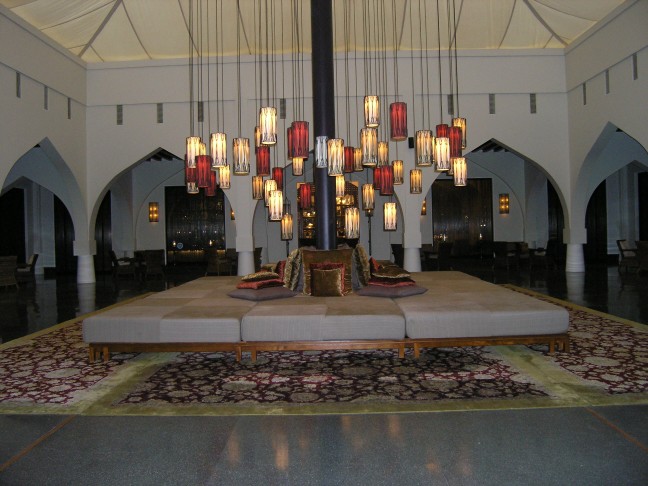
The Chedi, main hall
Atmosphere
Unlike the Hyatt or the Al Bustan Palace I felt
at home right away in the Chedi.
Spacious, tranquil, nice relax lounges, a library with nature books, a large,
nicely designed garden for an evening walk, and most importantly, discrete
guests you hardly notice. This is very different in the Hyatt and Al Bustan
which can be noisy when they fill up in the tourists seasons with package
tourists.
The Chedi is said to be a Feng-Shui designed
hotel, see e.g.
[1]. Possibly, this makes the difference.
I tend to invite the local people, mostly colleagues
I visit, to The Chedi for a dinner on the terrace and a garden stroll. They
always appreciate this as they are often not aware of the existence of such a
nice garden in the dry and rocky region of Muscat.
At night the charcoal fires in the bowls [1] are fascinating to watch and very
relaxing. In 2004, they were still using glass bowls with a few large square
pieces of charcoal put on top of each other like a small pyramid. The see-through
at the burning square blocks was mysterious. A year later, in 2005 I only saw
the gray granite bowls.
Last year I bought souvenirs in the tourist
shop. It has fine goods typical for South-East Asia, mostly Indonesian, with
clothes dominating. A young French girl was still working there.
Breakfast in the weekend is enjoyable on the
restaurant terrace outside [1].
In late April it can be already warm in
the morning, around 36 C. Most guest stay inside but I tend to enjoy a very
slow breakfast with the daily newspaper, the Oman Observer, which has
reasonable news from around the world although mostly very educating or little
opinionated.
Restaurant
The local expat community
in Muscat tends to head for the restaurant to the right of the main hall [1] [2] [3] [4], rarely staying in the hotel given
the steep price of over 200 Euros but
they have weekend deals for locals. The terrace [1] of the restaurant has limited
space and needs to be booked a few days ahead of time.
Garden
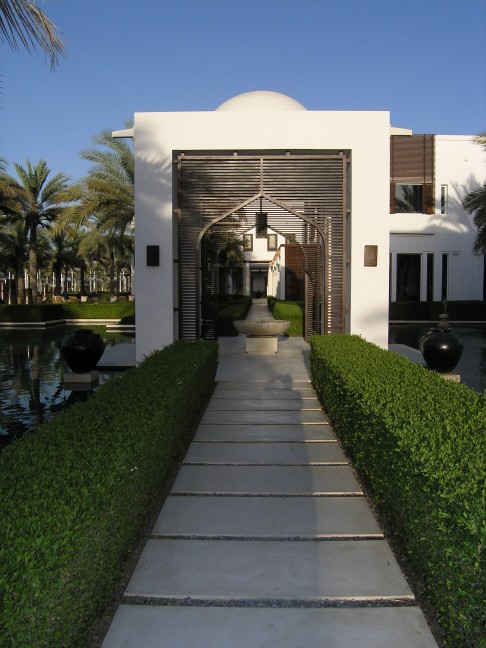
Main garden walkway
through the main pond
The garden is most special
by the palm trees [1] [1] [1], fountains, ponds [1],
walkways, fountains [1] [1] [1], brown vases [1] [1] and desert plants [1] [1]. I got a similar feeling as
in the summer palace in Beijing, nature dominates over people.
Walking at night in the
dimly lit garden is like meditating, you hear the rustling sound of fountains
and you let your thoughts flow. Very pieceful.
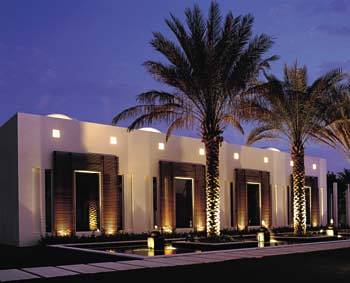
The Chedi, bungalow
rooms by night.
Vases, jars, fireplaces and sticks
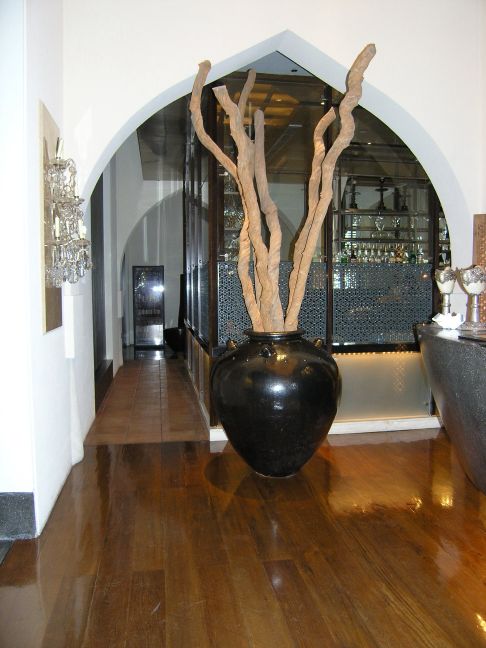
Sticks in a jar.
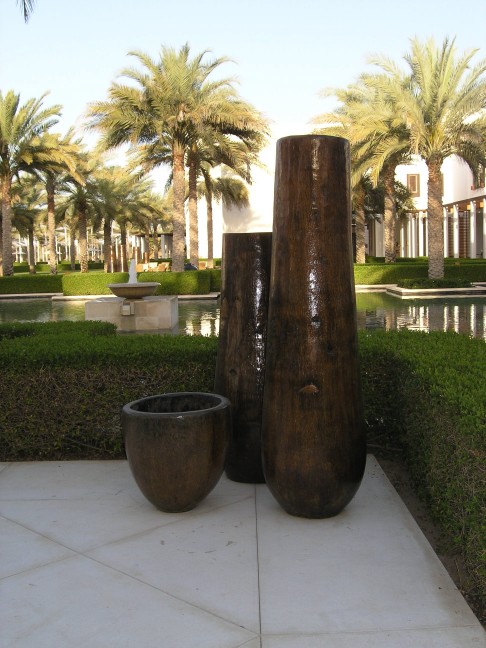
The Chedi, large wooden
vases. In 2004, a kitten was hiding in the middle vase.
The ornaments are very
simples, basically large wooden vases [1],
large jars [1] [1], fireplace bowls [1] and rough branches [1] [1] .
Pools
There are two pools, one in
the main garden and one near the sea.
The pool in the main garden
has a sheltered terrace [1]
and covered lounge areas for groups of 4-6 people. Children are not allowed in
the seaside pool.
When swimming in the sea
pool you have the feeling that the water is continuous with the sea as the
water flows over the edge of the pool. The toilets are again special, with a
stick guarding the entrance [1].
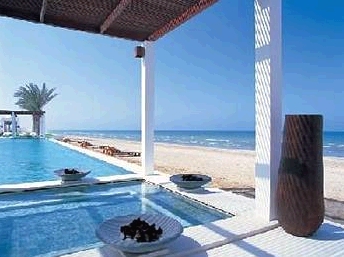
The Chedi, sea pool
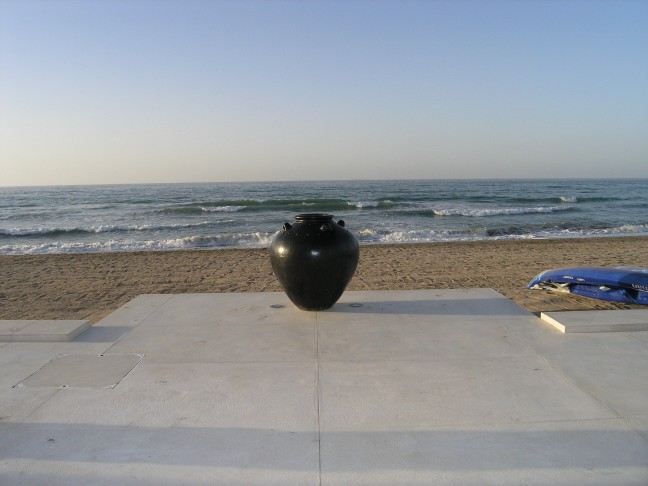
The Chedi, vase at the
sea pool, overlooking the sea.
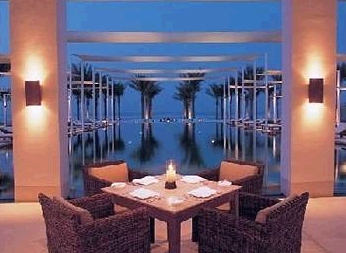
The Chedi, garden pool
by night.
Rooms
The rooms have a simple
design, with a dark stone floor, white walls and dark brown furniture. Some
Europeans may find it too simple when used to plush Victorian rooms. There are
also bungalows [1] in the
garden which are larger.
In 2004 I had a room
overlooking the garden pool. The corridor of my room was in open connection
with the outside air and a few mosquitoes got into my room at night, attracted
by the light below the door. Many rooms are inside and next time I would take
an inside room as April is can be a mosquito season.
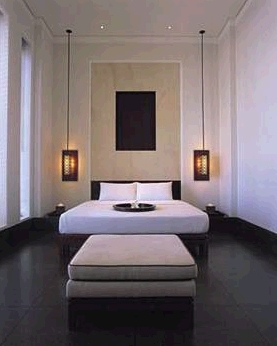
The Chedi, standard
room.
Summary
Staying in
The Chedi feels like living in a private museum of modern art but without the
paintings. I recommend it highly, one of the top hotels in the world, like the
other GHM Hotels.
More pictures
Ponds with trees.
Pool at the main building.
Walk way on the beach.
Walk way on the beach.
Fish restaurant on the beach.
Fish restaurant on the beach.
Walk way neat the main building.
Court yard.
Court yard.
Court yard.
Near the restaurant, shelter with ponds.
Bowl of fire.
Terrace, main dining area.
The pool with Ali.
The pool with Ali, Ahmed and Jean.
Fish restaurant on the beach with Ali, Ahmed and Jean.
Fish restaurant on the beach, whale vertebra bones.
Fish restaurant on the beach, wine glas, unfinished.
